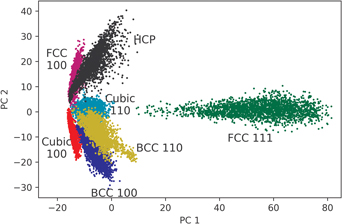Crossref Citations
This article has been cited by the following publications. This list is generated based on data provided by
Crossref.
Pospelov, Gennady
Van Herck, Walter
Burle, Jan
Carmona Loaiza, Juan M.
Durniak, Céline
Fisher, Jonathan M.
Ganeva, Marina
Yurov, Dmitry
and
Wuttke, Joachim
2020.
BornAgain: software for simulating and fitting grazing-incidence small-angle scattering.
Journal of Applied Crystallography,
Vol. 53,
Issue. 1,
p.
262.
Melton, Charles N
Noack, Marcus M
Ohta, Taisuke
Beechem, Thomas E
Robinson, Jeremy
Zhang, Xiaotian
Bostwick, Aaron
Jozwiak, Chris
Koch, Roland J
Zwart, Petrus H
Hexemer, Alexander
and
Rotenberg, Eli
2020.
K-means-driven Gaussian Process data collection for angle-resolved photoemission spectroscopy.
Machine Learning: Science and Technology,
Vol. 1,
Issue. 4,
p.
045015.
Ushizima, Daniela
McCormick, Matthew
and
Parkinson, Dilworth
2020.
Accelerating Microstructural Analytics with Dask for Volumetric X-ray Images.
p.
41.
Chai, Chengping
Maceira, Monica
Santos‐Villalobos, Hector J.
Venkatakrishnan, Singanallur V.
Schoenball, Martin
Zhu, Weiqiang
Beroza, Gregory C.
and
Thurber, Clifford
2020.
Using a Deep Neural Network and Transfer Learning to Bridge Scales for Seismic Phase Picking.
Geophysical Research Letters,
Vol. 47,
Issue. 16,
Ikemoto, Hiroyuki
Yamamoto, Kazushi
Touyama, Hideaki
Yamashita, Daisuke
Nakamura, Masataka
and
Okuda, Hiroshi
2020.
Classification of grazing-incidence small-angle X-ray scattering patterns by convolutional neural network.
Journal of Synchrotron Radiation,
Vol. 27,
Issue. 4,
p.
1069.
Van Herck, Walter
Fisher, Jonathan
and
Ganeva, Marina
2021.
Deep learning for x-ray or neutron scattering under grazing-incidence: extraction of distributions.
Materials Research Express,
Vol. 8,
Issue. 4,
p.
045015.
Chen, Zhantao
Andrejevic, Nina
Drucker, Nathan C.
Nguyen, Thanh
Xian, R. Patrick
Smidt, Tess
Wang, Yao
Ernstorfer, Ralph
Tennant, D. Alan
Chan, Maria
and
Li, Mingda
2021.
Machine learning on neutron and x-ray scattering and spectroscopies.
Chemical Physics Reviews,
Vol. 2,
Issue. 3,
Greco, Alessandro
Starostin, Vladimir
Hinderhofer, Alexander
Gerlach, Alexander
Skoda, Maximilian W A
Kowarik, Stefan
and
Schreiber, Frank
2021.
Neural network analysis of neutron and x-ray reflectivity data: pathological cases, performance and perspectives.
Machine Learning: Science and Technology,
Vol. 2,
Issue. 4,
p.
045003.
Alshehri, Abdullah H.
Loke, Jhi Yong
Nguyen, Viet Huong
Jones, Alexander
Asgarimoghaddam, Hatameh
Delumeau, Louis‐Vincent
Shahin, Ahmed
Ibrahim, Khaled H.
Mistry, Kissan
Yavuz, Mustafa
Muñoz‐Rojas, David
and
Musselman, Kevin P.
2021.
Nanoscale Film Thickness Gradients Printed in Open Air by Spatially Varying Chemical Vapor Deposition.
Advanced Functional Materials,
Vol. 31,
Issue. 31,
Kim, Kook Tae
and
Lee, Dong Ryeol
2021.
Probabilistic parameter estimation using a Gaussian mixture density network: application to X-ray reflectivity data curve fitting.
Journal of Applied Crystallography,
Vol. 54,
Issue. 6,
p.
1572.
Huang, Xinyi
Jamonnak, Suphanut
Zhao, Ye
Wang, Boyu
Hoai, Minh
Yager, Kevin
and
Xu, Wei
2021.
Interactive Visual Study of Multiple Attributes Learning Model of X-Ray Scattering Images.
IEEE Transactions on Visualization and Computer Graphics,
Vol. 27,
Issue. 2,
p.
1312.
Starostin, Vladimir
Munteanu, Valentin
Greco, Alessandro
Kneschaurek, Ekaterina
Pleli, Alina
Bertram, Florian
Gerlach, Alexander
Hinderhofer, Alexander
and
Schreiber, Frank
2022.
Tracking perovskite crystallization via deep learning-based feature detection on 2D X-ray scattering data.
npj Computational Materials,
Vol. 8,
Issue. 1,
Chavez, Tanny
Roberts, Eric J.
Zwart, Petrus H.
and
Hexemer, Alexander
2022.
A comparison of deep-learning-based inpainting techniques for experimental X-ray scattering.
Journal of Applied Crystallography,
Vol. 55,
Issue. 5,
p.
1277.
Andrejevic, Nina
2022.
Machine Learning-Augmented Spectroscopies for Intelligent Materials Design.
p.
1.
Mareček, David
Oberreiter, Julian
Nelson, Andrew
and
Kowarik, Stefan
2022.
Faster and lower-dose X-ray reflectivity measurements enabled by physics-informed modeling and artificial intelligence co-refinement.
Journal of Applied Crystallography,
Vol. 55,
Issue. 5,
p.
1305.
Ayush, Kumar
Seth, Abhishek
and
Patra, Tarak K
2023.
nanoNET: machine learning platform for predicting nanoparticles distribution in a polymer matrix.
Soft Matter,
Vol. 19,
Issue. 29,
p.
5502.
Jung, Florian A.
and
Papadakis, Christine M.
2023.
Strategy to simulate and fit 2D grazing-incidence small-angle X-ray scattering patterns of nanostructured thin films.
Journal of Applied Crystallography,
Vol. 56,
Issue. 5,
p.
1330.
Anker, Andy S.
Butler, Keith T.
Selvan, Raghavendra
and
Jensen, Kirsten M. Ø.
2023.
Machine learning for analysis of experimental scattering and spectroscopy data in materials chemistry.
Chemical Science,
Vol. 14,
Issue. 48,
p.
14003.
Boulle, A
and
Debelle, A
2023.
Convolutional neural network analysis of x-ray diffraction data: strain profile retrieval in ion beam modified materials.
Machine Learning: Science and Technology,
Vol. 4,
Issue. 1,
p.
015002.
Hinderhofer, Alexander
Greco, Alessandro
Starostin, Vladimir
Munteanu, Valentin
Pithan, Linus
Gerlach, Alexander
and
Schreiber, Frank
2023.
Machine learning for scattering data: strategies, perspectives and applications to surface scattering.
Journal of Applied Crystallography,
Vol. 56,
Issue. 1,
p.
3.


